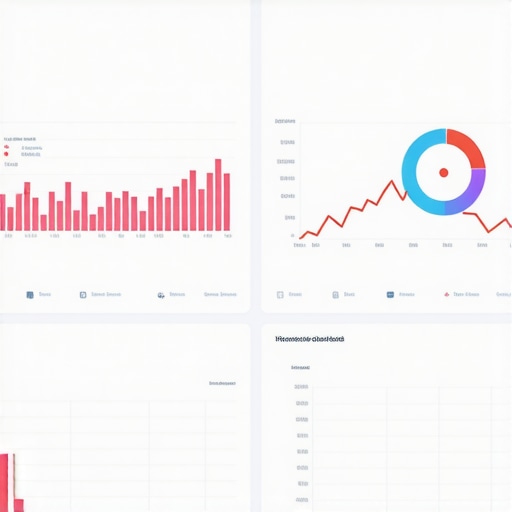Harnessing the Power of Google Keyword Planner for Advanced GMB Optimization Strategies
In the competitive landscape of local SEO, the integration of data-driven tools such as the Google Keyword Planner has become essential for businesses aiming to elevate their local search visibility. This article explores the nuanced application of keyword research in optimizing Google My Business (GMB) profiles, illuminating how expert practitioners leverage these insights to dominate local search rankings.
Why Keyword Data is the Linchpin of GMB Success
Effective GMB optimization transcends mere profile completeness; it demands a strategic alignment with user intent and local search patterns. By tapping into the latent semantic fields surrounding your niche, keyword planning enables precise targeting. Advanced practitioners analyze search volume fluctuations, seasonality, and competitive density, fostering a granular understanding of local consumer behavior. This approach transforms keyword selection into a tactical advantage, facilitating content curation and profile refinement that resonate with potential customers.
Deep Dive: Semantic SEO and Keyword Contextualization
Semantic SEO principles emphasize the importance of contextually relevant keywords within your GMB profile. Incorporating LSI (Latent Semantic Indexing) keywords—such as synonyms, related terms, and long-tail variations—ensures that your listing appeals to a broader spectrum of search queries. For example, a landscaping firm might target “garden design” alongside related terms like “landscape architecture” and “yard makeover,” thus capturing diverse user intents and enhancing local relevance.
Expert Insights: Balancing Keyword Volume and Local Relevance
One of the core debates among SEO professionals concerns the optimal balance between high-volume generic keywords and hyper-local search terms. While broad keywords attract traffic, they often lack the specificity needed for local conversion. Conversely, hyper-local keywords—such as “plumber in Brooklyn”—may have lower search volume but higher conversion potential. Employing Google Keyword Planner’s advanced filters allows practitioners to identify high-impact keywords that align with their business goals, often through a combination of broad and niche targeting.
How can professionals effectively filter and prioritize local keywords in Google Keyword Planner for GMB optimization?
Filtering and prioritizing local keywords involve a systematic approach: utilize the ‘Location’ filter to focus on your service area, analyze the search volume data for seasonal trends, and assess competition metrics to gauge difficulty. Combining these insights with your business’s unique value propositions ensures that your keyword strategy remains targeted and effective. This meticulous process is essential for creating a GMB profile that ranks prominently, especially in competitive markets.
For further mastery, consider integrating your keyword strategy with review management and citation building, amplifying your local authority and visibility.
Ready to deepen your understanding? Explore expert-level content on GMB citation strategies and contribute your insights to the evolving landscape of local SEO.
Unlocking the Next Level of Local SEO with Keyword Precision
In the evolving landscape of local search, merely understanding keyword fundamentals is no longer sufficient. Today, advanced practitioners harness sophisticated tools and techniques to craft hyper-targeted keyword strategies that ensure their Google My Business (GMB) profiles stand out amidst fierce competition. This entails a nuanced analysis of search intent, competitor keyword gaps, and emerging local trends, transforming keyword research from a routine task into a strategic powerhouse.
How Can Data-Driven Insights Shape Your Local Keyword Arsenal?
Leveraging data from tools like Google Keyword Planner, combined with third-party analytics, allows for a granular understanding of your target audience’s search behaviors. By analyzing patterns such as long-tail variations and seasonal fluctuations, local businesses can proactively adapt their content and profile optimizations. For example, a boutique fitness studio might identify spikes in searches for “outdoor yoga classes” during spring, prompting targeted GMB posts and service updates that capitalize on these trends.
Semantic SEO: The Key to Contextually Rich GMB Profiles
Semantic SEO extends beyond keyword stuffing, emphasizing the importance of contextually relevant content that aligns with user intent. Incorporating LSI (Latent Semantic Indexing) keywords—such as related services, neighborhood identifiers, and colloquial search terms—ensures your listing resonates with a broad spectrum of queries. This approach not only enhances visibility but also fortifies your profile’s authority within local search ecosystems.
Expert Tips: Balancing Competitive and Niche Keywords for Maximum Impact
One prevailing challenge is finding the sweet spot between high-volume, competitive keywords and highly specific, niche terms with lower competition. Advanced strategies involve creating a tiered keyword hierarchy, where broad keywords attract initial visibility, and niche keywords drive highly qualified traffic. Integrating these insights into your profile’s description, services, and posts can markedly improve your chances of outranking competitors, especially in densely populated markets. For a comprehensive approach, consider incorporating insights from local SEO competitive analysis.
What innovative keyword filtering techniques can help you stay ahead in local search rankings?
Implementing advanced filtering techniques—such as geo-modifiers, seasonality filters, and competitor keyword gap analysis—enables a laser-focused approach to keyword selection. Tools like Moz Local and BrightLocal offer additional features to refine your targeting, ensuring your GMB profile captures the most relevant and profitable search queries. This strategic filtering, combined with continuous monitoring and adjustment, forms the backbone of a resilient local SEO strategy.
To further refine your approach, explore how effective GMB ranking strategies can integrate seamlessly with your keyword plan, amplifying your local visibility and customer engagement.
Leveraging Competitive Analysis for Hyper-Targeted Local Keyword Optimization
In the realm of local SEO, understanding your competitive landscape is paramount. Advanced practitioners utilize tools such as Ahrefs and SEMrush to perform comprehensive keyword gap analyses, revealing high-value search terms your competitors are ranking for but you are not. This insight allows for the creation of hyper-targeted content and profile optimizations that directly address unmet search intents within your service area, dramatically increasing your GMB visibility.
How to Implement Dynamic Keyword Tracking for Continuous Optimization
Static keyword strategies quickly become obsolete in the volatile landscape of local search. To stay ahead, integrate dynamic tracking systems using tools like Google Data Studio and custom scripts that monitor fluctuations in search volume, ranking positions, and competitor movements in real time. By establishing a feedback loop, your local SEO efforts adapt swiftly to seasonal trends, emerging keywords, and algorithm updates, ensuring sustained dominance.
What are the most effective methods for integrating real-time keyword data into your GMB optimization workflow?
Effective integration involves setting up automated alerts for significant ranking shifts or search volume changes, combined with weekly review cycles. Use APIs from Google Search Console and third-party rank trackers to feed data into dashboards that highlight actionable insights. This proactive approach allows for timely adjustments to your profile content, posts, and service descriptions, maintaining relevance and authority in your local market.
Semantic Clustering: Creating Contextually Coherent Keyword Ecosystems
Moving beyond individual keywords, semantic clustering organizes related terms into coherent groups that reflect user search intent and contextual relevance. Advanced SEO practitioners develop clusters around core themes—such as “emergency plumbing services” or “luxury wedding photography”—and optimize GMB profile sections accordingly. This method enhances topical authority, improves ranking for broader query sets, and reduces keyword cannibalization.
For example, a dental practice might cluster keywords like “best family dentist,” “pediatric dentist near me,” and “emergency dental services,” creating a comprehensive topical map that guides content creation and profile optimization. Leveraging tools like Keyword Cupid or Market Brew can automate this process, allowing for scalable semantic strategy development.
How Can You Harness Latent Semantic Indexing to Elevate Your Local Search Presence?
Latent Semantic Indexing (LSI) enriches your keyword strategy by incorporating related terms and contextual signals that search engines use to understand content relevance. Implementing LSI involves embedding synonyms, related service terms, and neighborhood identifiers naturally within your GMB description, posts, and service listings. This nuanced approach ensures your profile resonates with a diverse array of search queries, bolstering your authority and visibility.
For instance, a boutique hotel targeting local travelers might include terms like “short-term stay,” “vacation rental,” “near downtown,” and “local attractions,” creating a rich semantic environment that captures multiple related searches.
Explore Further: How to Develop an Iterative, Data-Driven Keyword Refinement System
The most sophisticated local SEO campaigns are iterative. They continuously test, analyze, and refine keyword selections based on performance data. Set up a structured process involving monthly audits using analytics platforms, A/B testing of profile descriptions and posts, and competitor benchmarking. Incorporate insights from customer reviews and Q&A sections to uncover emerging long-tail keywords and colloquial search terms, ensuring your GMB profile evolves in tandem with local search behaviors.
By embedding these advanced techniques into your local SEO strategy, you position your business as a dominant force in your niche. As search algorithms grow increasingly sophisticated, a data-driven, semantically rich, and dynamically optimized keyword approach will be your most powerful tool for sustained success in Google Local Search.
Elevating GMB Profiles Through Semantic Clustering and Latent Semantic Indexing
Building upon foundational keyword research, advanced practitioners now turn to semantic clustering, which involves organizing related keywords into thematic groups that mirror user intent and contextual relevance. This approach not only enhances topical authority but also reduces keyword cannibalization, allowing GMB profiles to rank more effectively across a broader spectrum of search queries. Tools like Market Brew and Keyword Cupid facilitate the creation of these semantic clusters, enabling scalable and precise optimization strategies.
How Can Latent Semantic Indexing (LSI) Be Leveraged to Amplify Local Search Visibility?
Latent Semantic Indexing (LSI) enriches keyword strategies by incorporating synonyms, related terms, and contextual signals that search engines interpret as indicators of content relevance. Embedding LSI keywords naturally within your GMB description, services, and posts ensures your profile resonates with a diverse array of search queries, thereby increasing authority and visibility. For example, a local bakery might integrate terms like “artisanal bread,” “pastry shop,” and “nearby cake shop” to capture various related searches effectively.

Implementing LSI involves strategic keyword placement within profile content, ensuring semantic richness while maintaining readability and user engagement. This nuanced approach prepares your GMB profile for future algorithm updates emphasizing context and relevance.
How Can Dynamic, Data-Driven Keyword Refinement Be Systematized for Continuous Growth?
To stay ahead in volatile local search landscapes, sophisticated SEO teams establish iterative workflows that leverage real-time data. Using APIs from Google Search Console, combined with third-party rank tracking tools like SEMrush and BrightLocal, businesses can monitor fluctuations in keyword rankings, search volumes, and competitor movements. Establishing monthly review cycles with automated dashboards enables the identification of emerging long-tail keywords, seasonal trends, and shifting user behaviors, ensuring your GMB profile evolves proactively.
Encouragingly, integrating these insights with customer review analysis and Q&A data reveals new long-tail opportunities and colloquial search terms, further refining your keyword ecosystem and maintaining a competitive edge.
Expert Insights & Advanced Considerations
1. Semantic SEO Elevates Local Relevance
Integrating Latent Semantic Indexing (LSI) keywords into your GMB profile enhances contextual relevance, making your listing more appealing to diverse search queries and bolstering authority within local search ecosystems.
2. Dynamic Keyword Tracking Ensures Continuous Optimization
Implementing real-time data monitoring through APIs and dashboards allows your team to adapt swiftly to search trends, seasonal fluctuations, and algorithm updates, maintaining a competitive edge in local SEO.
3. Semantic Clustering Builds Topical Authority
Organizing related keywords into thematic clusters around core service areas helps in reducing keyword cannibalization and establishing your authority on broader topics, improving rankings across multiple search intents.
4. Competitor Gap Analysis Unveils Hidden Opportunities
Utilize advanced tools like SEMrush or Ahrefs to identify high-value keywords your competitors are ranking for but you are not, enabling targeted content creation and profile optimization strategies.
5. Integrating Review and Citation Strategies Amplifies Visibility
Coupling keyword strategies with review management and citation building enhances local authority, trustworthiness, and ranking potential, creating a holistic approach to GMB optimization.
Curated Expert Resources
- Market Brew: Offers sophisticated semantic analysis tools for developing topical clusters and understanding search intent at a granular level.
- SEMrush and Ahrefs: Industry-leading platforms for competitor analysis, keyword gap identification, and backlink insights, essential for advanced local SEO strategies.
- Google Data Studio: Enables real-time tracking dashboards that integrate search data, ranking fluctuations, and competitor movements for proactive optimization.
- Google Keyword Planner: The foundational tool for initial keyword research, with advanced filtering options for hyper-local targeting and seasonal trends.
- Customer Review Platforms: Integrate insights from review analysis tools to identify colloquial and long-tail keywords, enriching your semantic profile.
Final Expert Perspective
In the evolving landscape of local SEO, leveraging expert insights and sophisticated tools transforms GMB optimization from routine to strategic mastery. By focusing on semantic relevance, dynamic data analysis, and competitor intelligence, businesses can achieve sustained visibility and authority within local search ecosystems. For those committed to excellence, continual learning and adaptation—supported by authoritative resources—are the keys to outperform competitors. Dive deeper into these strategies and share your insights at our comprehensive local SEO guide. Remember, in this game, knowledge and agility are your greatest assets.


